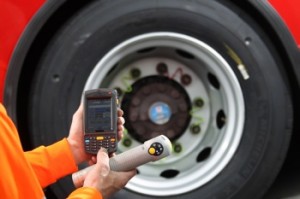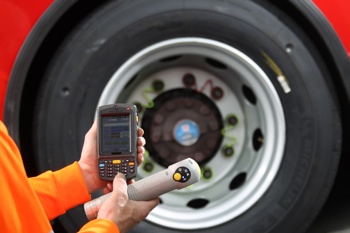In the early days of World War II, both sides were using radar to warn of approaching planes. At first, there was no way for either side to tell enemy planes from “friendlies.” This deficiency led to some major mistakes; like when an Army radar in Hawaii spotted the Japanese planes on their way to bomb Pearl Harbor but misidentified them as American B-17 Flying Fortresses.
The Germans discovered a crude method of radio frequency identification (RFID) that was useful when their planes returned to base. If pilots rolled their planes as they approached, it alerted the radar crew that these were German planes and not Allied aircraft.

The British developed a more sophisticated RFID system that is still used today called Identification Friend or Foe (IFF). When a transmitter on a British plane received a radar signal, it broadcasted the IFF signal back that identified the aircraft as friendly.
Advances in RFID continued after the war. Among the first wide-spread commercial uses were anti-theft systems that used electronic surveillance tags to determine whether an item had been paid for or not.
RFID use has continued to expand. By the1970s, uses included keyless door locking systems, a system for securing nuclear materials, automated toll payment systems, and a tag injected under the skin of cows to track movements and vaccination records.
Higher radio frequencies were adopted to increase range and speed up data transfer rates, and today RFID is used to track reusable containers, for access control, payment systems and contactless smart cards. To prevent theft, the steering columns of most cars now contain readers that sense the RFID tag embedded in the car key. The car won’t start if it doesn’t receive the correct identification number.
Modern RFID Technology
There are two broad categories of RFID systems: passive and active. Passive RFID tags do not have a transmitter; they simply reflect back radio waves from a reader. Active tags have their own transmitter and a power source. They broadcast a signal to transmit the information stored on the tag.
Active tags are generally used on large assets that need to be tracked over long distances. They generally cost from $10 to $50 per unit, depending on the amount of memory, the battery life required, whether the tag includes other sensors, and the ruggedness required.
Passive RFID tags have no power source and no transmitter. They are much cheaper than active tags (20 to 40 cents), require no maintenance and have a much shorter read range than active tags. A passive RFID tag consists of a microchip attached to an antenna – special packaging can be used to resist heat, cold or harsh chemicals.
The cost of RFID technology is the biggest limitation on its use. The savings generated by an RFID system justifies its use in some applications, especially when the tags can be reused. But where tags are put on products by one company and read by another, cost has been a major obstacle.
RFID and Tires Today
Direct TPMS is a form of active RFID devices that measure the inflation pressure of each tire and communicates with the vehicle’s computer system. But the TPMS supplies no information about the tire itself. Tire manufacturers are moving in that direction, however.
In 2013, Kumho Tire Co. announced plans to embed a passive RFID tag in all of the 35 million tires it produces in its factories to enable them to be tracked at the factory, through the supply chain, at stores and by owners. In 2012, Michelin began supplying tires with RFID tags to some London buses. The tags are used in conjunction with embedded wireless air pressure sensors. During a tire inspection, a handheld reader reads the number encoded on the RFID tag to identify the tire and read the pressure sensor. Finally, the operator utilizes the reader to determine tread depth. The pressure and tread-depth data is linked with the tire’s identification number and sent to a database.
Goodyear and Dunlop have both taken RFID into motorsports. In 2000, Goodyear introduced the technology to NASCAR. Currently, Goodyear uses RFID tags on all the tires it produces for NASCAR’s Sprint Cup, Nationwide and Camping World truck racing.
In Europe, the Dunlop MSA British Touring Car Championship successfully pioneered automatic scanning of tires in the pit lane. In the FIA European Truck Racing Championship, all Goodyear truck race tires are built with RFID tags inside. This year, Dunlop introduced RFID technology to the Moto2 and Moto3 classes of the MotoGP motorcycle racing series.
These spec-tire race series closely control the number of tires allocated to each team and require that specific constructions be used at designated tracks. RFID ensures no tire is missed and the race organizers are provided with an accurate log of each tire’s activity.
This is still a relatively simple use of the technology. The next stage will be to provide real time feedback from the tires, passing the data back to monitoring systems using active, rather than passive, RFID chips.
RFID and Consumers Today
Jason Roanhouse, marketing program manager for Bridgestone Americas commercial unit, notes that RFID provides benefits such as inventory management and casing tracking that help alleviate costs associated with the technology. Daniel Guiney, director technical service for Yokohama Tire Corp., acknowledged that the costs and benefits are still slanted heavily to truck fleets, large OTR tires and aircraft, and that volume utilization is needed to make use in consumer tires a reality.
Because a RFID tag doesn’t monitor or report temperature and inflation, expanded use of RFID is likely to be initially limited to identification. However, according to Roanhouse, Bridgestone is looking at several technologies that will provide real-time data, such as temperature and inflation, in addition to other valuable information.
What about using RFID tags to improve tire manufacturers’ ability to effectively recall tires? While an RFID tag can provide very detailed information on a specific tire or group that Roanhouse believes would help in a recall situation, Guiney points out that the additional equipment required for reading RFID chips is costly and not widely available in the general tire service network.
What can dealers realistically expect to see and when? Guiney says, probably continued technology testing combined with small scale, high-end expansion and careful evaluation of longevity and tire quality effects. Roanhouse states that the basic capabilities have been developed and Bridgestone is working to incorporate them in a way that will be the most meaningful, and cost effective.
The Future May Be Here
Continental AG’s electronic-Tire Information System (eTIS) may point the way to the future of RFID in tires.
Aimed at auto manufacturers, eTIS is integrated into the innerliner and combines RFID with other advanced functions to assist in maintaining proper tire pressure; provide load detection, notification for winter/summer tire change and tread depth information; integrate tire information regarding road conditions with the vehicle chassis; and reduce weight compared to standard TPMS sensors and readers.
Of particular interest to the aftermarket is the system’s purported ability to read and report tire tread depths, creating a way to alert drivers of an approaching critical condition and, perhaps, even alerting their chosen tire dealer to expect a call.
Continental predicts that eTIS will eventually make the leap to wirelessly connect tire and road information into car-to-car and car-to-infrastructure transportation management systems – massive projects which Continental is already working on.
This kind of interactive system will enable critical road condition information to be passed on to other vehicles approaching the same road stretch and allow drivers to safety navigate the hazard. That sounds ambitious, but 20 years ago who would have believed what our cell phones do every day?














